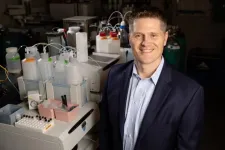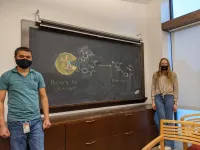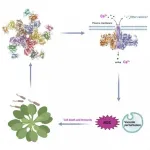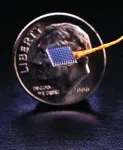Mutation profile of acral nevi differs from acral melanoma, Moffitt researchers say
BRAF V600E mutations are common in acral nevi
2021-05-12
(Press-News.org) TAMPA, Fla. -- Melanocytic nevi, or moles, are nonmalignant growths that arise from pigment producing cells of the skin. They are mostly found in sun-exposed areas; however, they also can be found in sun-protected areas, such as the palms, soles of feet and nail beds, where they are known as acral nevi. While the mutation profile of nevi in sun-exposed areas is well understood, less is known about the genes that are commonly mutated in acral nevi. And while a subset of melanoma of sun-exposed skin arises in nevi, the link between nevi and melanoma in acral skin is poorly understood. In a new study published in JAMA Dermatology, Moffitt Cancer Center researchers report on the mutation profile of acral nevi and describe differences between acral nevi and acral melanoma.
Melanoma is one of the most common types of cancer, with an estimated 100,000 new cases diagnosed in 2020 in the United States. Acral melanoma is a subtype on nonsun-exposed areas of the skin and is not linked to ultraviolet radiation exposure. Despite both conditions being derived from pigment-producing melanocytes, melanoma and acral melanoma differ in several ways. Patients with acral melanoma tend to have a poorer response to treatment and a higher mortality rate than patients with typical melanoma. Additionally, the two types of melanoma differ in their mutation profile.
Approximately 30% of malignant melanoma are derived from nonmalignant melanocytic nevi. One of the most common genetic alterations in melanocytic nevi, as well as melanoma, are mutations in the BRAF gene.
To determine if there is a genetic link between acral nevi and acral melanoma, Moffitt researchers performed a genetic analysis on 50 acral nevi from 49 patients - 19 males and 30 females. They discovered that unlike acral melanoma, activating mutations in the BRAF gene were very common in the nevi, with 86% of patients having a mutation in the BRAF gene. Additionally, 10% of the patients had activating mutations in the NRAS gene, which were mutually exclusive from BRAF mutations.
These observations demonstrate that acral nevi and acral melanoma have different mutation patterns. "Acral nevi demonstrated a mutational spectrum very similar to that of nevi on sun-exposed skin, suggesting that acral nevi are unlikely to be the precursor lesion for the majority of acral melanomas," said Keiran Smalley, Ph.D., study author and director of Moffitt's Donald A. Adam Melanoma and Skin Cancer Center of Excellence. "We hope our findings will lead to a better understanding of how acral melanoma develops."
"This is the largest series of acral nevi that have been sequenced to date, and the results were surprising to me," said Jane Messina, M.D., senior study author and senior member in the Department of Cutaneous Oncology. "Additionally, most of our patients were white/European in origin, while previous studies were mostly performed in Asian populations where there is a much higher frequency of acral nevi. The frequent presence of a mutation with a strong link to sun exposure suggests that even acral skin may be subject to the ravages of the sun."
INFORMATION:
This study was supported by the Melanoma Research Alliance and National Cancer Institute (P30-CA076292).
About Moffitt Cancer Center
Moffitt is dedicated to one lifesaving mission: to contribute to the prevention and cure of cancer. The Tampa-based facility is one of only 51 National Cancer Institute-designated Comprehensive Cancer Centers, a distinction that recognizes Moffitt's scientific excellence, multidisciplinary research, and robust training and education. Moffitt is the No. 11 cancer hospital and has been nationally ranked by U.S. News & World Report since 1999. Moffitt's expert nursing staff is recognized by the American Nurses Credentialing Center with Magnet® status, its highest distinction. With more than 7,000 team members, Moffitt has an economic impact in the state of $2.4 billion. For more information, call 1-888-MOFFITT (1-888-663-3488), visit MOFFITT.org, and follow the momentum on Facebook, Twitter, Instagram and YouTube.
ELSE PRESS RELEASES FROM THIS DATE:
2021-05-12
NEW YORK, NY--While there was extensive use of drug repurposing throughout the first 10 months of the COVID-19 pandemic, there was substantial heterogeneity over the types of drugs used for treatment purposes globally. Some drugs, including hydroxychloroquine, saw sharp declines in use, while adjunctive therapies grew into a more relied upon method for patient management.
In a number of cases, scientific discovery overturned misconceptions proclaimed via press conferences and social media.
The OHDSI network study "Use of repurposed and adjuvant drugs in hospital patients with covid-19: multinational network cohort study," published May 11 by The BMJ, provides a global view ...
2021-05-12
URBANA, Ill. - Gut health is having a moment, with sales of fermented foods such as kefir, kombucha, and kimchi steadily on the rise. The benefits of "good bacteria" in fermented foods and supplements go well beyond the gut, moderating immune responses, heart health, weight, and even mood. But do products hold up to the claims on their labels?
A new study from the University of Illinois and The Ohio State University examined bacterial content of five brands of kefir, a fermented dairy beverage often likened to drinkable yogurt. The research showed the majority of products overstated bacterial density and contained species not included on the label.
"Our ...
2021-05-12
The ability to connect and feel a sense of belonging are basic human needs but new Swansea University research has examined how these are determined by more than just our personal relationships.
Research led by psychologist Professor Andrew Kemp, of the College of Human and Health Sciences, highlights the importance of taking a wider approach to wellbeing and how it can be influenced by issues such as inequality and anthropogenic climate change.
Professor Kemp worked with PhD student Jess Mead and consultant clinical psychologist Dr Zoe Fisher, of the University's Health and Wellbeing Academy, on the study which presents a transdisciplinary ...
2021-05-12
CHAMPAIGN, Ill. -- Young people with diverse gender identities may be bullied and victimized up to three times more often than peers who identify as male or female, a new study of more than 4,464 adolescents in Illinois found.
The students were part of a statewide survey of eighth- through 12th-grade youths in Illinois schools.
"Transgender youths reported the highest rates of all forms of peer victimization, which were double to nearly triple those of males and up to 2.6 times higher than those of females," said social work professor Rachel Garthe of the University of Illinois Urbana-Champaign, who led the research.
"Slightly ...
2021-05-12
Can a protein found in a mosquito lead to a better understanding of the workings of our own brains? Prof. Ofer Yizhar and his team in the Weizmann Institute of Science's Neurobiology Department took a light-sensitive protein derived from mosquitos and used it to devise an improved method for investigating the messages that are passed from neuron to neuron in the brains of mice. This method, reported today in Neuron, could potentially help scientists solve age-old cerebral mysteries that could pave the way for new and improved therapies to treat neurological and psychiatric conditions.
Yizhar and his lab team develop so-called optogenetic methods - research techniques that allow them to "reverse engineer" the activity of specific brain circuits ...
2021-05-12
EAST LANSING, Mich. - As climate change threatens global food security, researchers at Michigan State University are building better beans crucial to human nutrition by tapping into the genetics of the more heat-resistant tepary bean.
The tepary bean (Phaseolus acutifolius A. Gray) is a sister of the common bean which includes kidney, pinto and navy beans. "The common bean is the number one source of protein and nutrients for many people living in Central America and Africa," said Robin Buell, a professor of plant biology in MSU's College of Natural Science and former director of the Plant Resilience Institute.
Her research on bean genetics was published May 11 in Nature Communications.
"Mother nature has already made plants that are adapted to different climates," ...
2021-05-12
Molecules are the building blocks for our modern world, from phones to cars to Doritos. But coming up with new ones is still an incredibly costly and time-consuming process. A group of University of Chicago chemists wants to find a better way.
"If you look at a diagram of a molecule, it seems like you should be able to just snap them together like Tinkertoys, but you can't," said Asst. Prof. Mark Levin. "We'd like to change that."
Their new discovery, published May 12 in Nature, represents a first step towards that transformation: a way to easily cut nitrogen atoms from molecules.
Despite decades of experiments, chemistry remains an art in many ways because molecules are built in a long, iterative process: attaching ...
2021-05-12
In plants, disease resistance proteins serve as major immune receptors that sense pathogens and pests and trigger robust defense responses. Scientists previously found that one such disease resistance protein, ZAR1, is transformed into a highly ordered protein complex called a resistosome upon detection of invading pathogens, providing the first clue as to how plant disease resistance proteins work. Precisely how a resistosome activates plant defenses, however, has been unclear.
A joint team led by Profs. ZHOU Jianmin, CHEN Yuhang and HE Kangmin at the Institute of Genetics and Developmental Biology of the Chinese Academy of Sciences and Prof. CHAI Jijie at Tsinghua University recently employed state-of-the-art electrophysiology and single-molecule imaging to investigate the molecular ...
2021-05-12
Scientists are exploring a number of ways for people with disabilities to communicate with their thoughts. The newest and fastest turns back to a vintage means for expressing oneself: handwriting.
For the first time, researchers have deciphered the brain activity associated with trying to write letters by hand. Working with a participant with paralysis who has sensors implanted in his brain, the team used an algorithm to identify letters as he attempted to write them. Then, the system displayed the text on a screen - in real time.
The innovation could, with further development, let people with paralysis rapidly ...
2021-05-12
PROVIDENCE, R.I. [Brown University] -- Researchers with the BrainGate collaboration have, for the first time, used an implanted sensor to record the brain signals associated with handwriting, and used those signals to create text on a computer in real time.
In a study published in the journal Nature, a clinical trial participant with cervical spinal cord injury used the system to "type" words on a computer at a rate of 90 characters per minute, more than double the previous record for typing with a brain-computer interface. This was done by the participant merely thinking about the hand motions involved in creating written letters.
The research team is hopeful that such a system could one day help to restore ...
LAST 30 PRESS RELEASES:
[Press-News.org] Mutation profile of acral nevi differs from acral melanoma, Moffitt researchers say
BRAF V600E mutations are common in acral nevi





